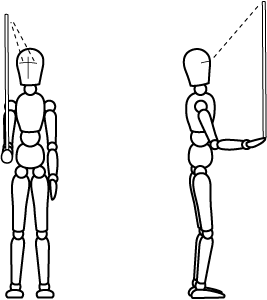5.5. Classical Control Theory¶
The human brain is very good in controlling systems. If you ever watched an infant learn to walk you know that even standing straight up is a hell of a job. Without active control of our muscles, without the sensors that tell our brain what the body is doing, standing up and walking would be nearly impossible.

Imagine balancing a broom stick standing freely on the tip of your finger. That is clearly an unstable systemm, just like the child trying to stand up and walk. A (very) small disturbance would make the broom stick fall over. It is because you are controlling your finger and continuously move it in the right direction that the stick does not fall.
These are nice examples of an inverted pendulum system. Other instable systems in the same category are: riding a monocycle and riding a segway.
Control theory is an important subject in science engineering. Control theory deals with the behaviour of dynamic systems and how to control such systems, i.e. make the system to react in an appropriate way when fed with a specific input.
Another example of a controlled system is a tank with water that has to be kept at a constant temperature. Sounds easy and it is relatively easy, even if you want the temperature to stay constant irrespective of external disturbances like someone throwing in a plastic bag with meat that is at room temperature whereas you would like to keep it at a constant temperature of say 60 degrees (this setup is known as ‘sous-vide’ cooking).

Fig. 5.46 A Sous-Vide Control System
The sous-vide control system (most engineers would call this a heated water tank system and it has many applications in industry…) controls the temperature using an electrical water heater that the controller can turn on or off. It measures the actual temperature of the water \(T\), compares this with the set temperature \(T_\text{set}\) and based on the error decides to turn the heater on or off.
The sous-vide system is an example of a feedback control system: the output is measured and is used to control the input to the system in such a way that a preset output is achieved. This in contrast with a feed forward system where we have good reason to believe that a control action will always have the result we expect it to have and there are no external disturbances to take care of. As an example of a feed forward system, think of a simple light switch: we seldomly build systems that check whether turning the switch really turns on the light.
A simple control strategy is to turn the heater on when \(\Delta T<0\) (remember that \(\Delta T\) is the set temperature minus the actual temperature) and to turn it off for \(\Delta T>0\). This is often called a “bang-bang controller”. What would you expect to be the temperature \(T\) as function of time \(t\)? Control theory tries to improve the behaviour of such controlled systems.
Learning control theory requires years of study, in these notes we give an introduction to what is called classical control theory. Control theory that deals with Single-Input-Singe-Outout Linear systems. That is only a small portion of all possible dynamic systems that need to be controlled: we won’t look at non linear systems (and unfortunately most real life systems are non linear) and we won’t deal with Multiple-Input-Multiple-Output systems.
We will show in this section that the block diagram description of signals and systems when using the Laplace transform of signals (and systems) is easy and provides a powerful tool to reason about these systems in the block diagrams that we have seen before.